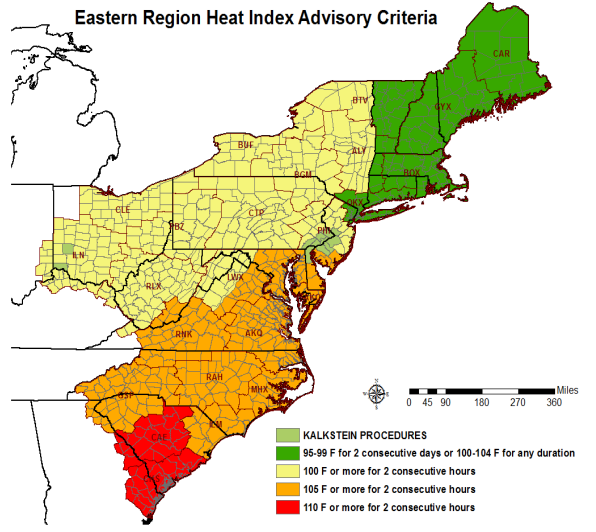Reduced Excessive Heat Warnings: Analyzing The Recent Trend

Table of Contents
Geographical Variations in Reduced Warnings
The decrease in excessive heat warnings isn't uniform across the globe. A regional analysis reveals a complex picture, with some areas experiencing a noticeable reduction while others see a concerning increase.
Regional Analysis
- Decreased Warnings: Several regions in Western Europe, for example, have reported a decrease in excessive heat warnings in recent years. This might be attributed to several factors, including:
- Improved urban planning and green infrastructure initiatives, mitigating the urban heat island effect.
- Investment in early warning systems and improved public communication strategies.
- More accurate meteorological data collection and analysis leading to more precise predictions.
- Increased Warnings: In contrast, regions in South Asia and parts of the United States have witnessed a rise in heat warnings. Potential contributing factors include:
- The undeniable effects of climate change, leading to more frequent and intense heatwaves.
- Rapid urbanization and deforestation, exacerbating the urban heat island effect.
- Increased vulnerability of certain populations due to socioeconomic factors and lack of access to cooling resources.
Data Sources and Methodology
The analysis presented here draws upon data from various reputable sources, including national meteorological agencies like the National Weather Service (NWS) in the US and the Met Office in the UK, along with reports from the World Meteorological Organization (WMO) and peer-reviewed scientific publications. Data consistency and limitations in reporting across different regions present a challenge to comprehensive analysis, a point which we will address later.
Improved Forecasting and Warning Systems
Technological advancements and increased public awareness initiatives play a significant role in the observed trend of reduced excessive heat warnings.
Technological Advancements
Significant progress in weather prediction technology has improved the accuracy and timeliness of heat warnings.
- Advanced Satellite Imagery: High-resolution satellite imagery provides detailed information about land surface temperatures, enabling more precise heatwave tracking.
- Sophisticated Weather Modeling: Improved numerical weather prediction (NWP) models offer better forecasting of extreme heat events, allowing for earlier and more accurate warnings.
- Data Assimilation Techniques: Advanced data assimilation techniques integrate various data sources (satellite, ground-based observations) to produce more reliable forecasts. These improvements lead to more targeted warnings, reducing the need for overly broad alerts.
Public Awareness Campaigns
Effective public awareness campaigns educate populations about the dangers of extreme heat and promote preventative measures.
- Heat Safety Tips Dissemination: Widespread dissemination of heat safety tips via social media, public service announcements, and community outreach programs.
- Early Warning Systems Integration: Integration of heat warnings into existing emergency alert systems ensures timely communication to vulnerable populations.
- Community-Based Initiatives: Local initiatives providing support to vulnerable populations during heatwaves, including access to cooling centers and hydration resources. These initiatives can reduce the severity of impacts and hence, the need for widespread alerts.
Potential Misinterpretations and Challenges
While reduced excessive heat warnings might seem positive, it's crucial to acknowledge potential misinterpretations and challenges.
Underreporting of Extreme Heat
A decrease in warnings doesn't necessarily reflect a decrease in the actual occurrence of extreme heat events.
- Data Gaps in Developing Countries: Many developing nations lack the infrastructure and resources for comprehensive monitoring and reporting of extreme heat events, leading to underreporting.
- Inconsistent Reporting Standards: Variations in reporting standards and definitions of "excessive heat" across different regions make it difficult to draw definitive global conclusions. This requires standardized reporting across global meteorological services.
- Focus on Localized Extreme Temperatures: The reliance on localized temperature readings to trigger warnings can sometimes under-represent larger scale events such as prolonged heatwaves.
False Sense of Security
Fewer warnings can create a false sense of security, leading to decreased preparedness.
- Complacency: People might become complacent, assuming the risk of heatstroke is lower when fewer warnings are issued.
- Lack of Personal Preparedness: A reduction in alerts might result in decreased personal preparedness, including neglecting heat safety measures like staying hydrated and seeking shade.
- Underestimation of the Severity: Fewer alerts might lead to an underestimation of the potential severity of extreme heat events, even during periods of fewer official warnings.
Conclusion
The trend of reduced excessive heat warnings is a complex issue requiring careful analysis. While advancements in forecasting and public awareness contribute to more targeted and effective warnings, potential underreporting and the risk of a false sense of security remain significant concerns. While the trend of reduced excessive heat warnings is noteworthy, understanding the nuances behind these changes is crucial for effective heat preparedness. Stay informed about local weather forecasts and take necessary precautions to mitigate the risks associated with excessive heat. Further research is needed to improve data collection and reporting standards across different regions and to fully understand the long-term impact of climate change on extreme heat events and the effectiveness of mitigation strategies.

Featured Posts
-
 Mlaeb Altrabyt Tshhd Talq Awstabynkw Tqryr Jdyd Mn Alshrq Alawst
May 30, 2025
Mlaeb Altrabyt Tshhd Talq Awstabynkw Tqryr Jdyd Mn Alshrq Alawst
May 30, 2025 -
 Florange Manque De Remplacement Et Probleme De Rats A L Ecole Bouton D Or
May 30, 2025
Florange Manque De Remplacement Et Probleme De Rats A L Ecole Bouton D Or
May 30, 2025 -
 Bruno Fernandes Transfer Saga Al Hilals Pursuit Intensifies
May 30, 2025
Bruno Fernandes Transfer Saga Al Hilals Pursuit Intensifies
May 30, 2025 -
 Arcelor Mittal En Russie Le 9 Mai 2025 Analyse De L Emission Franceinfo
May 30, 2025
Arcelor Mittal En Russie Le 9 Mai 2025 Analyse De L Emission Franceinfo
May 30, 2025 -
 Andre Agassis Professional Pickleball Debut Tournament Details
May 30, 2025
Andre Agassis Professional Pickleball Debut Tournament Details
May 30, 2025
Latest Posts
-
 Alcaraz Through To Barcelona Open Round Of 16 Following Ruud
May 31, 2025
Alcaraz Through To Barcelona Open Round Of 16 Following Ruud
May 31, 2025 -
 Racial Abuse Case Beautician Receives No Jail Time
May 31, 2025
Racial Abuse Case Beautician Receives No Jail Time
May 31, 2025 -
 Musks Dogecoin Support No Regrets Over Trump Administration Involvement
May 31, 2025
Musks Dogecoin Support No Regrets Over Trump Administration Involvement
May 31, 2025 -
 Elon Musks Cost Cutting 101 Million In Dei Spending And 8 Million On Transgender Mice Eliminated
May 31, 2025
Elon Musks Cost Cutting 101 Million In Dei Spending And 8 Million On Transgender Mice Eliminated
May 31, 2025 -
 Elon Musks Pressure Campaign Did Trumps Team Block An Open Ai Uae Deal
May 31, 2025
Elon Musks Pressure Campaign Did Trumps Team Block An Open Ai Uae Deal
May 31, 2025
